Related Research Articles

Jefferson F. Davis was an American politician who served as the first and only president of the Confederate States of America from 1861 to 1865. He represented Mississippi in the United States Senate and the House of Representatives as a member of the Democratic Party before the American Civil War. He was the United States Secretary of War from 1853 to 1857.
CSS Scorpion was a Squib-class torpedo boat that served in the Confederate States Navy during the American Civil War. Armed with a single spar torpedo, she originally served guard duty on the James River after being built in late 1864. Along with the rest of the James River Squadron, Scorpion moved downriver on January 23, 1865, and participated in the Battle of Trent's Reach. After performing depth soundings near Union obstructions, Scorpion moved to get a lantern from the ironclad CSS Virginia II, but ran into a hawser and then ran aground. At 07:10 on the morning of January 24, Union fire struck the abandoned tender CSS Drewry, which then exploded. The force of the explosion swept Scorpion out of control downriver. An attempt to rescue her that night failed, and she was captured by Union forces.

The flags of the Confederate States of America have a history of three successive designs during the American Civil War. The flags were known as the "Stars and Bars", used from 1861 to 1863; the "Stainless Banner", used from 1863 to 1865; and the "Blood-Stained Banner", used in 1865 shortly before the Confederacy's dissolution. A rejected national flag design was also used as a battle flag by the Confederate Army and featured in the "Stainless Banner" and "Blood-Stained Banner" designs. Although this design was never a national flag, it is the most commonly recognized symbol of the Confederacy.

Varina Anne Banks Howell Davis was the only First Lady of the Confederate States of America, and the longtime second wife of President Jefferson Davis. She moved to the Presidential Mansion in Richmond, Virginia, in mid-1861, and lived there for the remainder of the Civil War. Born and raised in the South and educated in Philadelphia, she had family on both sides of the conflict and unconventional views for a woman in her public role. She did not support the Confederacy's position on slavery, and was ambivalent about the war.
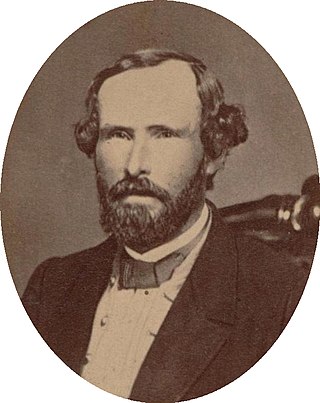
George Wythe Randolph was a Virginia lawyer, planter, politician and Confederate general. After representing the City of Richmond during the Virginia Secession Convention in 1861, during eight months in 1862 he was the Confederate States Secretary of War during the American Civil War, then served in the Virginia Senate representing the City of Richmond until the war's end.
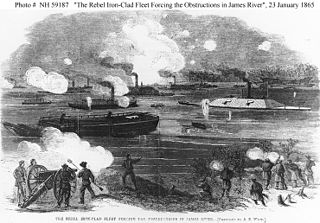
CSS Virginia II was a Confederate Navy steam-powered ironclad ram laid down in 1862 at the William Graves' shipyard in Richmond, Virginia. Acting Constructor William A. Graves, CSN, was the superintendent in charge of her construction. In order to conserve scarce iron plating, he ordered the ship's armored casemate shortened from the specifications given in John L. Porter's original building plans; in addition, the ship's iron-plating, while six inches thick on the casemate's forward face, was reduced to five inches on her port, starboard, and aft faces. Due to the shortening of her casemate, the number of her cannon were reduced to a single 11" smoothbore, a single 8" rifle, and two 6.4" rifles.

George Washington Custis Lee, also known as Custis Lee, was the eldest son of Robert E. Lee and Mary Anna Custis Lee. His grandfather George Washington Custis was the step-grandson and adopted son of George Washington and grandson of Martha Custis Washington. He served as a Confederate general in the American Civil War, primarily as an aide-de-camp to President Jefferson Davis, and succeeded his father as president of Washington and Lee University in Lexington, Virginia.

CSS Richmond was the name ship of her class of six casemate ironclads built for the Confederate States Navy during the American Civil War. Completed during 1862 the ship was assigned to the James River Squadron where she mostly supported Confederate forces near Richmond, Virginia. She was burned in April 1865 to prevent her capture by Union forces.
The CSS Beaufort was an iron-hull gunboat that served in North Carolina and Virginia during the American Civil War. Originally launched as Caledonia at Wilmington, Delaware, in 1854, the ship was owned by James Cathcart Johnston. It saw use as a tugboat on the Dismal Swamp Canal. On July 9, 1861, Beaufort was commissioned into the navy of the state of North Carolina for use in the American Civil War. First serving on the North Carolina coast, Beaufort was present at the battles of Roanoke Island and Elizabeth City in February 1862. Escaping the Confederate defeat at Elizabeth City via the Dismal Swamp Canal, Beaufort reached Norfolk, Virginia, where she joined the James River Squadron.

CSS Fredericksburg was a casemate ironclad that served as part of the James River Squadron of the Confederate States Navy during the American Civil War. Laid down in 1862 and Launched the following year, she did not see action until 1864 due to delays in receiving her armor and guns. After passing through the obstructions at Drewry's Bluff in May 1864, she participated in several minor actions on the James River and fought in the Battle of Chaffin's Farm from September 29 to October 1. On January 23 and 24, 1865, she was part of the Confederate fleet at the Battle of Trent's Reach, and was one of only two Confederate ships to make it past the obstructions at Trent's Reach. After the Confederate attack failed, Fredericksburg withdrew with the rest of the James River Squadron. On April 3, as the Confederates were abandoning Richmond, Fredericksburg and the other vessels of the James River Squadron were burned. Her wreck was located in the 1980s, buried under sediment.

The Second White House of the Confederacy is a historic house located in the Court End neighborhood of Richmond, Virginia. Built in 1818, it was the main executive residence of the sole President of the Confederate States of America, Jefferson Davis, from August 1861 until April 1865. It was viewed as the Confederate States counterpart to the White House in Washington, D.C. It currently sits on the campus of Virginia Commonwealth University.

The Dahlgren affair was an incident during the American Civil War which stemmed from a failed Union raid on the Confederate capital of Richmond, Virginia in March 1864. Brigadier General Hugh Judson Kilpatrick and Colonel Ulric Dahlgren led an attack on Richmond to free Union prisoners from Belle Isle and damage Confederate infrastructure.
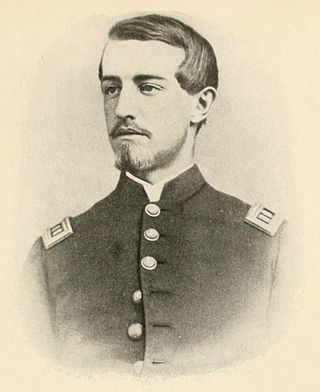
Ulric Dahlgren was a colonel in the Union Army during the American Civil War. He was the son of Union Navy Rear Admiral John A. Dahlgren and nephew to Confederate Brigadier General Charles G. Dahlgren.
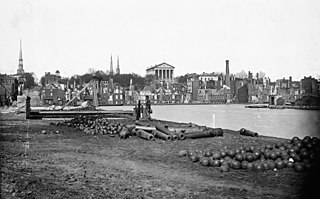
Richmond, Virginia served as the capital of the Confederate States of America during the American Civil War from May 8, 1861, hitherto the capital had been Montgomery, Alabama. Notwithstanding its political status, it was a vital source of weapons and supplies for the war effort, as well as the terminus of five railroads, and as such would have been defended by the Confederate States Army at all costs.

George Julian Zolnay was a Romanian, Hungarian, and American sculptor called the "sculptor of the Confederacy".
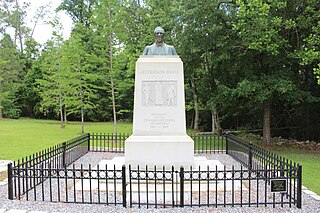
Jefferson Davis Memorial Historic Site is a 12.668-acre (5.127 ha) state historic site located in Irwin County, Georgia that marks the spot where Confederate States President Jefferson Davis was captured by United States Cavalry on Wednesday, May 10, 1865. The historic site features a granite monument with a bronze bust of Davis that is located at the place of capture. The memorial museum, built in 1939 by the Works Progress Administration, features Civil War era weapons, uniforms, artifacts and an exhibit about the president's 1865 flight from Richmond, Virginia to Irwin County, Georgia.

Jubal Anderson Early was an American lawyer, politician and military officer who served in the Confederate States Army during the Civil War. Trained at the United States Military Academy, Early resigned his United States Army commission after the Second Seminole War and his Virginia military commission after the Mexican–American War, in both cases to practice law and participate in politics. Accepting a Virginia and later Confederate military commission as the American Civil War began, Early fought in the Eastern Theater throughout the conflict. He commanded a division under Generals Stonewall Jackson and Richard S. Ewell, and later commanded a corps.
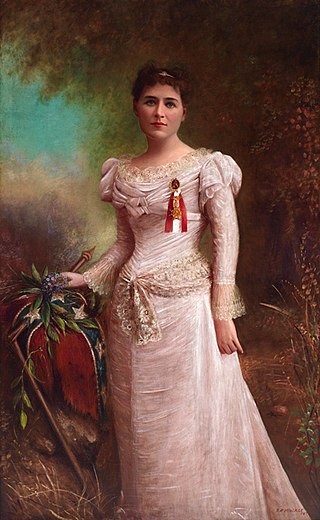
Varina Anne "Winnie" Davis was an American author who is best known as the youngest daughter of President Jefferson Davis of the Confederate States of America and Varina (Howell) Davis. Born in the last year of the war, by the late 1880s she became known as the "Daughter of the Confederacy". Images of her were widely circulated when she was young, helping morale. Later in the 1880s, she appeared with her father on behalf of Confederate veterans' groups. After his death, she and her mother moved in 1891 to New York City, where they both worked as writers. She published a biography and two novels, in addition to numerous articles. Davis died from an infectious disease at age 34.

The Squib class torpedo boats were built for the Confederate States Navy during the later stages of the American Civil War. After the torpedo boat CSS David attacked and damaged the ironclad USS New Ironsides, the Confederates continued building torpedo boats with hopes of breaking the Union blockade. Four vessels of the class – CSS Hornet, CSS Wasp, CSS Squib, and CSS Scorpion – were constructed in Richmond, Virginia, in 1864. All were armed with a single spar torpedo and were powered by steam engines. Squib damaged the gunboat USS Minnesota in an attack on April 9, 1864, and was later sent to Wilmington, North Carolina, where she was scuttled in February 1865. The other three vessels of the class were all part of the James River Squadron and participated in the Battle of Trent's Reach on the night of January 23 and 24, 1865. Scorpion ran aground during the battle, and was forced downriver and out of control after the tender CSS Drewry exploded on January 24. She was later captured by Union forces and may have been burned. Hornet was sunk in a collision with another vessel on January 27, and Wasp was scuttled on the night of April 2/3, as the Confederates were abandoning Richmond.
References
- ↑ Coski, John M. (Winter 2008). "What do we really know about Jim Limber?". Museum of the Confederacy Magazine. pp. 18–19.
- ↑ Trent, Sydney. "Jim Limber and the myth of the Confederate president's adopted Black son". Washington Post. ISSN 0190-8286. Archived from the original on April 10, 2022. Retrieved April 10, 2022. (pp B1&B6 in print edition of April 18, 2022)
- 1 2 3 "Civil War Center Accepts Donated Davis Statue". International Herald Tribune. Associated Press. August 14, 2008. Archived from the original on September 19, 2008.
- 1 2 Coski, John M. (March 8, 2014) [2009]. "Limber, Jim". Encyclopedia Virginia. Virginia Foundation for the Humanities. Retrieved April 7, 2018.
- ↑ Crist, Lynda (ed.). The Papers of Jefferson Davis: 1808-1840. Vol. 11. LSU Press. p. 547.
- ↑ Szkotak, Steve (June 17, 2008). "Confederate group offers statue to Civil War Center". Fox News. Associated Press. Retrieved August 29, 2020.
- ↑ Jones, Will (June 10, 2008). "Statue of Jefferson Davis is proposed". Richmond Times-Dispatch. Archived from the original on February 12, 2012.